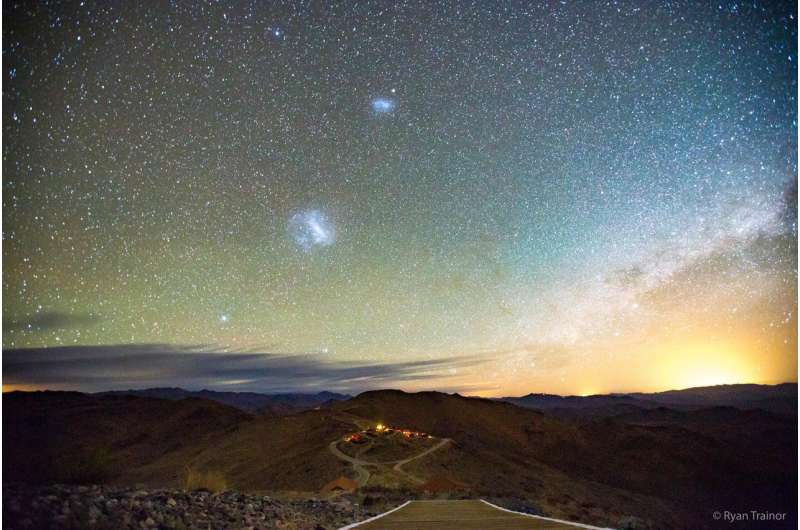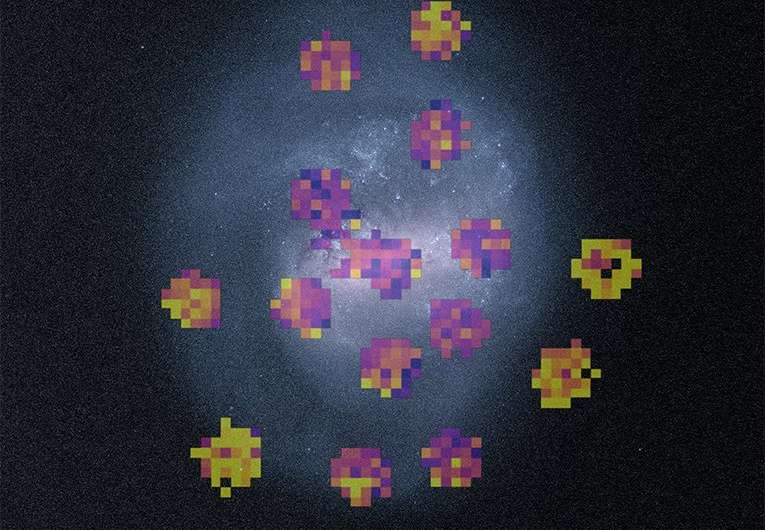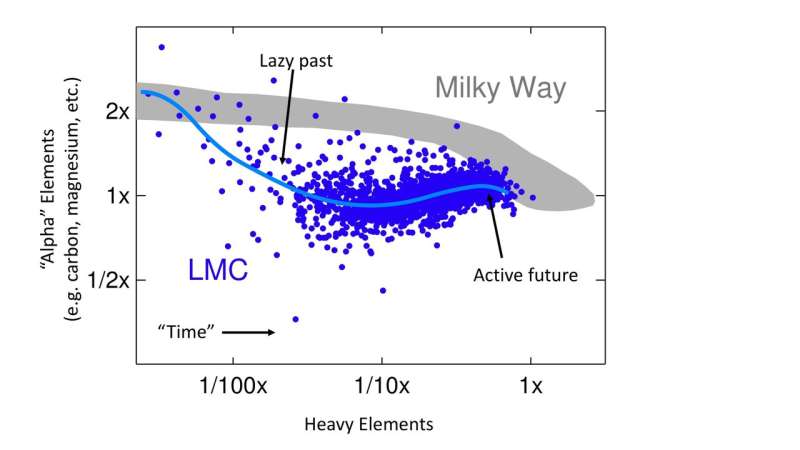Magellanic Clouds prove it's never too late to get active

Wondering about that New Year's Resolution to get more exercise?
Good news from the Milky Way's nearest neighbors, the Magellanic Clouds: it's never too late to get active.
After a "lazy" start of star formation for the first few billion years of their lives, both the Large and Small Magellanic Clouds are now forming new stars at a rapid rate.
Astronomers from the Sloan Digital Sky Survey (SDSS) reached that conclusion by making, and then analyzing, the first-ever detailed chemical maps of galaxies beyond our own.
"We mapped the positions, movements, and chemical compositions of thousands of stars in these nearby galaxies," says study leader David Nidever, a research professor of physics at Montana State University with a joint appointment at the National Optical Astronomical Observatory (NOAO). "Reading these maps helps us reconstruct the history of how these galaxies formed their stars."
The Large and Small Magellanic Clouds are the Milky Way's nearest galactic neighbors—companion galaxies that will someday merge with our galaxy. They are named for explorer Ferdinand Magellan, who led the first European expedition to circumnavigate the globe. The two galaxies are visible only from the Southern Hemisphere, where they look like bright, wispy clouds. Although humans have been looking at them for millennia, this is the first time astronomers have made a detailed map of the chemical compositions of the stars within them.

"Because these galaxies are only visible from the Southern Hemisphere, we needed to look at them from our telescope in Chile," says Jennifer Sobeck, a Senior Research Scientist at the University of Washington and Project Manager for the southern operations of the SDSS's Apache Point Observatory Galaxy Evolution Experiment 2 (APOGEE-2) survey. APOGEE-2 put SDSS instruments—identical to the ones on the Sloan Foundation Telescope in New Mexico—on the Irénée du Pont Telescope at Las Campanas Observatory in Chile. "These maps are the first major discovery to come out of our new southern 'eye on the sky,'" Sobeck added.
The key to making these new maps is to collect spectra of as many stars as possible. Spectra are observations of the amount of light that stars give off at various wavelengths, or colors. Spectra of stars reveal many things about them, such as how they are moving, their temperature, the chemical elements they contain, and their stage in the stellar life cycle. The APOGEE-2 South spectrograph works primarily at infrared wavelengths, longer than the human eye can see. The maps of the Magellanic Clouds that Nidever's team made relied on the ability of spectra to reveal the chemical compositions of stars.
Measuring the detailed chemical abundances found in stars can provide both a clock and a speedometer for star formation, because of how the elements in our universe are created. Hydrogen and helium came from the Big Bang, but most heavier elements were formed deep inside stars, and only get released at the end of a star's life, often by supernova explosions. That means that if you add up all the heavier-than-helium elements you can see in all stars in a galaxy, the total provides a measure of how many stars that galaxy has formed during it life. What's more, the composition of stars reveals the composition of the gas cloud they were made from, serving as a clock for recording the star's age.
Team member Sten Hasselquist from the University of Utah explains, "stars make different types of elements depending on their size. Heavier stars make and release extra amounts of so-called 'alpha elements,' like carbon, oxygen, neon, and magnesium." Early on in a galaxy's history, stars add a lot of alpha elements to the galaxy, but as time passes, the rate of these alpha elements get balanced out by other elements, made in smaller-mass stars—unless a new burst of star formation occurs and throws off the balance again. "With the 'clock' of all heavy elements and the 'speedometer' of alpha elements, we can make detailed models to reconstruct the rate of star formation throughout a galaxy's history," Hasselquist adds.

The results show that both the Large and Small Magellanic Clouds have had histories very different from that of the Milky Way. Their stars' relative abundances of alpha elements came into balance at much lower value of heavy elements (earlier times) than the Milky Way's, indicating a "lazy" first few billion years in which few new stars formed. But very recently, alpha elements have become more plentiful, indicating a burst of recent star formation.
"Both the Magellanic Clouds started off by making stars very slowly," says Christian Hayes of the University of Virginia, a key member of the research team. "But within the past two billion years or so, they suddenly became much more active. We think this is due to the interaction of the Magellanic Clouds with one another as they both tumbled toward the Milky Way."
Over the next several billion years, both Magellanic Clouds will continue to merge with the Milky Way, as the gravitational force of our much larger galaxy pulls them in, and thus will start to form stars at an even greater rate than they do now. Recent work has shown that in about 2.5 billion years the Large Magellanic Cloud will be consumed by the Milky Way with a cosmic explosion of star formation. Our nearest neighbors may have had a lazy past, but they have been much more active recently, and will have even a much more active future. It's never too late to get active.
Provided by Sloan Digital Sky Survey




















